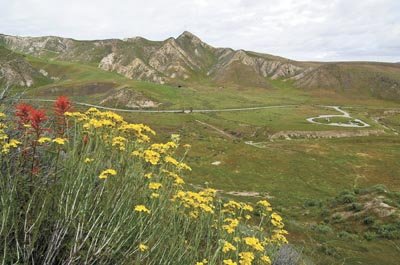In idle moments, I sometimes sit with a map and simply look for
empty or unusual places.
In idle moments, I sometimes sit with a map and simply look for empty or unusual places. While our bay basin and its network of valley corridors cradles six-plus million of us, we are close to a number of wild and sparsely populated areas. Corral Hollow, Del Puerto Canyon, Panoche Valley — these places are in the journals of Juan Bautista de Anza and William Brewer. They are part of the legend of Joaquin Murrieta, but most of us have never been to any of them.
Marty Cheek had sent me emails suggesting we team up for a trip to Panoche Valley (see Cheek’s column about the trip in the Features of the Morgan Hill Times). His friend, Veronica, lives on 40 acres near there and had been trying to coax Marty out for a visit. One day last week, just ahead of spring’s last gasp, we took Veronica up on her invitation.
Directions are simple: Take Highway 25 south past Hollister, past Tres Pi’os to Paicines; turn left on Panoche Road and go, go, go. The road rolls and twists through a quiet valley cut by Tres Pinos Creek. Twenty miles and a half hour down Panoche Road, Cheek commented that we had not seen a single car. By day’s end, we wouldn’t see many more.
With Veronica as our guide, we crossed Panoche Pass and began descending toward the valley. Usually when we coast-dwellers head inland, we climb the deeply folded Diablo Range to a pass — Altamont or Pacheco — from which we descend past more wrinkled country to the Central Valley. Not here. Few things have surprised me more than the appearance of Panoche Valley. Here the land relaxes into a vast open expanse — perhaps 10 miles long and 3 miles wide — well before reaching the Central Valley.
Past the turnoff to Mercy Hot Springs, the Panoche Road becomes the New Idria Road and turns south along Griswold Creek. Just before the road climbs into the Griswold Hills, we parked at a Bureau of Land Management Access Point and set out on foot.
We crossed a weak and turbid Griswold Creek and entered the hills beyond. There are no trails, so we traced the recesses as our whims dictated, passing a rich variety of wildflowers (among them, two species of delphinium and an onion) that I don’t see close to home. Unable to resist the views waiting above, I climbed to the top of an adjacent hill.
Since returning from Panoche Valley, I have been unable to forget it. It has left me strangely and pleasantly confounded. Were this place in Wyoming or Montana, it would be typical. But only an hour and a half drive from home, it becomes something marvelous. To many eyes, Panoche Valley is too barren to be beautiful. On my hilltop, I was among California juniper trees that were not much more that shrubs. Looking a great distance north across Panoche Valley, there were virtually no other trees.
Starting home, still in the valley, we stopped at Claravale Dairy Farm where Veronica picked up some fresh raw milk. We chatted with the diary owner by the side of the road for a long while. During that time two vehicles passed, the occupants always offering a wave. He explained that his ranch buildings are the structures that used to be the entire town of Panoche — post office, exchange, etc.
And don’t miss the Panoche Inn — a watering hole right out of a movie: pool table, a juke box (two plays for a quarter) with your favorite Buck Owens songs, and great conversation. Back outside, immensity and silence. I couldn’t get over it — still can’t. Moonless nights here must be fantastic.










